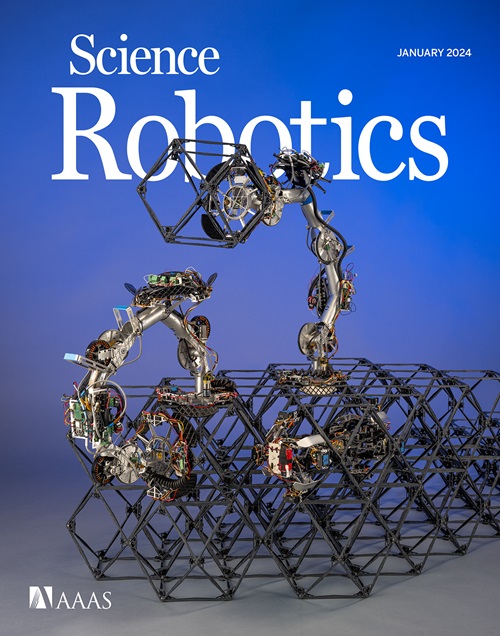Learning contact-rich whole-body manipulation with example-guided reinforcement learning
IF 27.5
1区 计算机科学
Q1 ROBOTICS
引用次数: 0
Abstract
Humans use diverse skills and strategies to effectively manipulate various objects, ranging from dexterous in-hand manipulation (fine motor skills) to complex whole-body manipulation (gross motor skills). The latter involves full-body engagement and extensive contact with various body parts beyond just the hands, where the compliance of our skin and muscles plays a crucial role in increasing contact stability and mitigating uncertainty. For robots, synthesizing these contact-rich behaviors has fundamental challenges because of the rapidly growing combinatorics inherent to this amount of contact, making explicit reasoning about all contact interactions intractable. We explore the use of example-guided reinforcement learning to generate robust whole-body skills for the manipulation of large and unwieldy objects. Our method’s effectiveness is demonstrated on Toyota Research Institute’s Punyo robot, a humanoid upper body with highly deformable, pressure-sensing skin. Training was conducted in simulation with only a single example motion per object manipulation task, and policies were easily transferred to hardware owing to domain randomization and the robot’s compliance. The resulting agent can manipulate various everyday objects, such as a water jug and large boxes, in a similar fashion to the example motion. In addition, we show blind dexterous whole-body manipulation, relying solely on proprioceptive and tactile feedback without object pose tracking. Our analysis highlights the critical role of compliance in facilitating whole-body manipulation with humanoid robots.
学习接触丰富的全身操作与例子引导强化学习
人类使用不同的技能和策略来有效地操纵各种物体,从灵巧的手部操作(精细运动技能)到复杂的全身操作(大运动技能)。后者涉及全身接触和广泛接触身体的各个部位,而不仅仅是手,其中我们的皮肤和肌肉的顺应性在增加接触稳定性和减轻不确定性方面起着至关重要的作用。对于机器人来说,综合这些接触丰富的行为具有根本性的挑战,因为这种接触量所固有的快速增长的组合学,使得对所有接触相互作用的明确推理变得难以处理。我们探索使用示例引导强化学习来生成强大的全身技能,以操纵大型和笨重的物体。我们的方法的有效性在丰田研究所的Punyo机器人上得到了证明,Punyo机器人是一个人形的上半身,具有高度可变形的压力感应皮肤。训练是在模拟中进行的,每个目标操作任务只有一个例子运动,并且由于领域随机化和机器人的顺应性,策略很容易转移到硬件。由此产生的智能体可以以类似于示例运动的方式操作各种日常物品,例如水壶和大盒子。此外,我们展示了盲灵巧的全身操作,仅仅依靠本体感觉和触觉反馈,而不需要物体姿态跟踪。我们的分析强调了顺应性在促进人形机器人的全身操作中的关键作用。
本文章由计算机程序翻译,如有差异,请以英文原文为准。
求助全文
约1分钟内获得全文
求助全文
来源期刊

Science Robotics
Mathematics-Control and Optimization
CiteScore
30.60
自引率
2.80%
发文量
83
期刊介绍:
Science Robotics publishes original, peer-reviewed, science- or engineering-based research articles that advance the field of robotics. The journal also features editor-commissioned Reviews. An international team of academic editors holds Science Robotics articles to the same high-quality standard that is the hallmark of the Science family of journals.
Sub-topics include: actuators, advanced materials, artificial Intelligence, autonomous vehicles, bio-inspired design, exoskeletons, fabrication, field robotics, human-robot interaction, humanoids, industrial robotics, kinematics, machine learning, material science, medical technology, motion planning and control, micro- and nano-robotics, multi-robot control, sensors, service robotics, social and ethical issues, soft robotics, and space, planetary and undersea exploration.
 求助内容:
求助内容: 应助结果提醒方式:
应助结果提醒方式:


